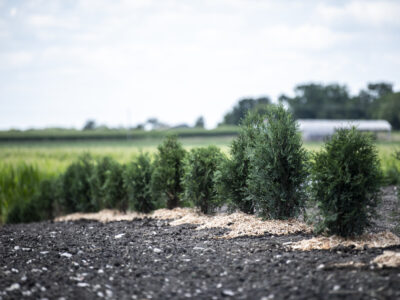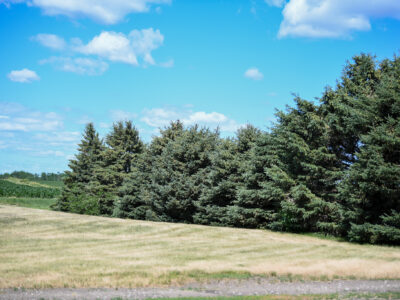Hot Topics in Windbreak Options
02-22-2016 in Green Farmstead Partner
A windbreak can be more than just a windbreak. It can provide wildlife and pollinator habitat, landscaping aesthetics, and even additional farm income.
At the recent Green Farmstead Partner Program Conference, hosted by the Coalition to Support Iowa’s Farmers, a panel of experts addressed participating landscape professionals highlighting three of today’s hottest trending topics:
Agroforestry opportunities for conventional livestock farmers
Specialty forest products often fit niche markets, but they can be labor intensive, take years to establish, and best grown on a small scale. That likely inhibits their attractiveness to traditional row crop and livestock producers.
But incorporating them into an overall conservation plan, especially windbreaks, can provide environmental and economic opportunity.
Jeff Jensen, with Trees Forever, is a nut grower specializing in hazelnuts. But that is certainly not the only option.
He says there is high demand for Chinese chestnuts, a crop well suited to southern Iowa’s climate and slightly acidic, well-drained soils. “They have the potential to reap more money per acre than corn and beans,” says Jensen.
Black walnuts grown in the wild have little value, but varieties grown as cultivars are valuable and desirable. Cultivars are available and once trees are established the market is receptive and growing.
Growing hazelnuts is a work in progress, with growers working to produce cultivars that will offer nut consistency. “They’re highly productive plants,” says Jensen, who is involved in the cultivar effort, as well as establishing best management practices and machine harvesting techniques. He says sites that can accommodate 50 plants or so are needed for field trials, making them an interesting option for livestock facility landscaping.
There are also markets for woody decorative florals such as pussy willows and holly or other floral greens. Some have seasonal appeal. Others may be perishable products. But, Jensen says do not think that means the markets are not structured and highly developed. Not only do the markets and distribution mechanisms exist, but the limited number of growers provides ample opportunity for new producers to join in.
Most specialty crops have statewide or regional associations that can be of benefit to the beginner. Jensen also advises downloading the Trees Forever Agroforestry Toolkit.
Aronia berries and pork production
Aronia berries and elderberries are good agroforestry options. Elderberries are well established in Missouri, and can be a viable alternative for Iowa as well.
Aronia berries are gaining a reputation in the health food world as a super fruit, and are gaining popularity in Iowa as a cash crop.
Corey Hillebo has added 15 acres of aronia berries to his hog barn site south of Madrid. Hillebo took over the site in 2013, enabling him to “farm where he wants to be.” Snow and neighbor issues prompted him to add windbreak plantings, and the possibilities of aronia berries caught his attention.
He liked the idea of farm diversification and the health benefits of the berries, as well as high potential for a return on his investment. The native berries are a hearty shrub, relatively easy to manage, and an attractive addition to the farm.
“For me they helped provide a path back to the farm,” says Hillebo.
Aronia berries will begin producing fruit in 2-3 years and reach full capacity of around 20 pounds per plant in 10 years. They are similar to a lilac in structure, making them ideal for windbreak snow control. Their dark green leaves, dark purple berries, white spring flowers, and bright red leaves in fall make them an attractive addition to any landscape.
They require no yearly pruning, are relatively disease and pest hardy, and can be harvested by hand or machine. Hillebo says weed control is essential and drip line irrigation is recommended. “It’s not necessary, but it is a good insurance policy, especially while plants are developing.”
High in antioxidants, the berries are rich in dietary fiber and Vitamin C, combat inflation, and boost cardiovascular health. They can be consumed fresh, frozen, juiced, or in jams or jellies. They are also found in animal foods, cosmetics, diet supplements, dyes and soaps. Product awareness in increasing, and so are marketing opportunities.
Hillebo suggests anyone interested in growing aronia berries contact the Midwest Aronia Association.
Incorporating pollinator habitat into windbreak design
Brad Riphagen of Trees Forever says producers should think outside the box and think of ways to incorporate pollinator habitat into their windbreaks. Bees and butterflies are necessary for plant pollination, and their natural environment is shrinking. As humans alter the landscape, natural habitat is hard to find.
“Native species need native plants,” says Riphagen of Iowa’s many species of pollinators. There are thousands of species of native bees in the state. “They have co-evolved. They know that plant.”
Area pollinators depend on a variety of plant colors and smells to do their job, and farmers have a unique opportunity to incorporate those plants into their conservation plans.
He says in some cases an organic buffer may be needed to protect plants, and he recommends registering with the Pesticide Sensitive Registry. Insecticides are often applied when buds are active, the exact time pollinators are at work.
Pumpkins, squash, watermelons, even milkweed can make for good options, as well as a variety of flowers and prairie grasses, providing pollinator-friendly flowers and ground nesting opportunities. And most plants that look good to a bee will also look good to you and your neighbors.
Trees Forever, the Iowa Nursery and Landscape Association and the CSIF, all partners in the Green Partner Farmstead Partner program can provide additional information.
By Terri Queck-Matzie for CSIF
Recommended News

Growing the Ag Environment
Ryan and Lana Reed of Wapello County spent an almost-spring-like March day tending to the windbreak near two of their hog barns. Planted in 2010, the fast-growing austree hybrid willow...
Read More
Ames Landscaper Joins Green Farmstead Partner Program
West Des Moines, Iowa – April 4, 2023 — Landscape Legends of Ames has been designated a participating landscape professional in the Coalition to Support Iowa’s Farmers’ (CSIF) Green Farmstead...
Read More
Derecho Brings Opportunity for Story County Family
Brian Sampson of Story County is an optimist. “I like to be around people who think most things are possible,” says Sampson. When the derecho rolled through his farm last...
Read More